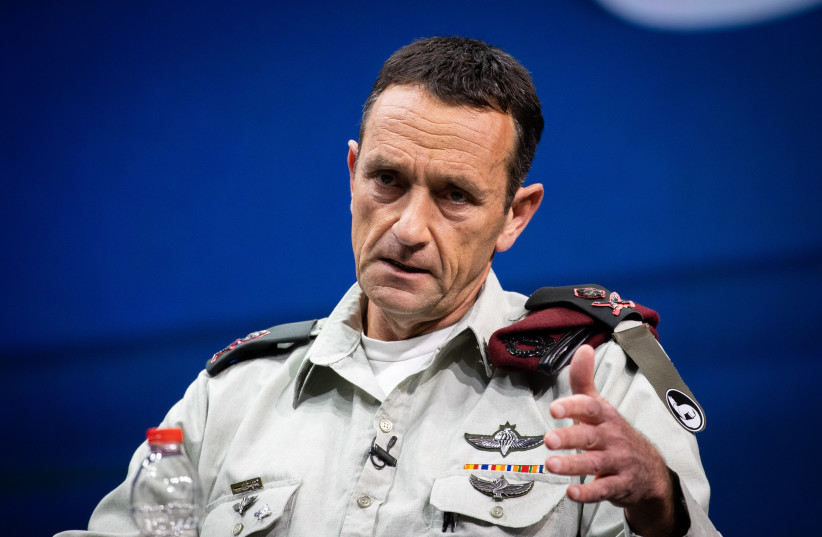IDF Chief-of-Staff Lt.-Gen. Herzi Halevi on Tuesday said that it could even take months to arrest or kill Hamas's top leaders and "many months" to finish fighting Hamas.
Halevi implied that he recognized the broader diplomatic and political context will not allow a full all-out war for that long and said that the IDF would adjust itself to different intensity levels of fighting as needed.
The IDF chief also said that Israel would need new security mechanisms and tactics even after the different levels of fighting became less intense to ensure long-term security for Israeli residents in the South.
A complex environment
“This war has critical goals which are not easy to achieve and take place in a complex environment. Therefore, this war will continue for many months, and we will act in different ways so that our achievements will be sustained over time,” said Halevi.
He said, “we will also get to the leaders of Hamas, whether it takes a week or months.”

Halevi described the IDF as having operational control of northern Gaza, while recognizing that Hamas forces who faded into the civilian populations will still emerge with ambushes from time to time.
Next, he said the IDF must ramp up its dominance in southern Gaza, where Khan Yunis is the new focal point, and also make sure it addresses Hamas in central Gaza, even as that mission is somewhat lower profile.
Another area where the IDF has increased its actions against Hamas is central Gaza.
IDF Division 36 is now attacking Hamas’s al-Bureij forces, estimated at around 1,000.
There are four battalions in central Gaza, counting al-Bureij, including also Deir al-Balah, Nuseirat, and Maghazi.
Despite killing Hamas’s Central Gaza Brigade Commander Ayman Nofal in October, mopping up Hamas’s forces in central Gaza is expected to take a period of weeks since they have mostly not been attacked to date.
Previously, Division 36 took over Shejaia, where it killed an estimated 935 Hamas terrorists, 735 of whom IDF forces identified, and 200 who escaped into buildings which were then destroyed.
Rocket fire from Gaza on Tuesday increased, but fewer than 25 sirens were heard on both the northern and southern fronts.
This came as the IDF significantly increased its firepower in Gaza, striking around 100 targets, with a special focus on southern Gaza.
In the North, nine soldiers were wounded by a Hezbollah anti-tank missile, one seriously.
An anti-tank missile seriously wounded a civilian guard near a church in the Shumrah region of Western Galilee. Soldiers were wounded by a second anti-tank missile when they came to aid the civilian.
In response, IAF planes attacked Hezbollah infrastructure in Lebanon, including a building to where a terrorist who launched an anti-tank missile had fled.
Hezbollah also launched a rocket from near a mosque located in the village of Yaroun in southern Lebanon toward Dovev in the Upper Galilee. Later, Hezbollah launched more rockets at the Yiftah area and Mount Dov area.
The IDF responded with tank and artillery fire against the sources of the shooting.
In yet another incident, a drone exploded in an open area in Ramim Ridge in Israel’s North on Tuesday.
At press time, the IDF had not commented on the incident.
Defense Minister Yoav Gallant stated on Tuesday that Israel was in the midst of a war on seven different fronts that would be a long, hard war with a heavy price.
“We are in a multi-arena war, we are being attacked from seven different sectors – Gaza, Lebanon, Syria, Israel, Iraq, Yemen and Iran,” Gallant told the Knesset Foreign Affairs and Defense Committee. “We have already responded and acted on six of these fronts, and I am saying here in the most explicit way anyone who acts against us is a potential target, there is no immunity for anyone.
“The State of Israel will know what to do,” Gallant continued. “The defense establishment is getting ready, the reality…the results in Gaza are seen and understood by everyone.”
“I want to tell you that this is a long, hard war. It comes with a price, a heavy price, but its justification is of the highest caliber,” Gallant stated.
“We were brutally and barbarically attacked to discourage us from living here. We must make it clear that whoever makes a move of this kind will be punished. Whether it takes months or whether it takes years, we need to wrap up this issue.”
On the Syrian border, a day after it was announced that Israel allegedly killed top Islamic Revolutionary Guard Corps (IRGC) official Sayyed Razi Mousavi while he was in Syria and after the IDF HomeFront Command issued a statement about the dangers of Iranian militias near Israel’s border with Syria, the Jordan Valley Regional Council said that the IDF statement had not constituted an operational “warning.”
The regional council was concerned to reassure residents and tourists that there was no need to be concerned about being near the border with Syria, as opposed to the border with Lebanon, which was evacuated in October.
